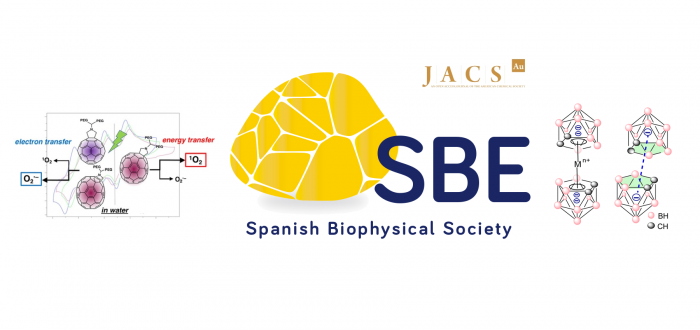The last two JACS Au papers of Prof. Miquel Solà have been highlighted in October and November by the Spanish Biophysical Society:
Photoinduced Reactions of C60 and C70 in Water
Three types of water-soluble fullerene derivatives were prepared from their Prato adducts by conjugation with PEG. One Prato derivative of C60 ([6,6]-addition) and two Prato derivatives of C70 (ab-[6,6] and cc-[6,6]-addition) with carboxylic acids were synthesized, purified and subjected to the amide-forming conjugation with amine-PEG to form corresponding C60– or C70-PEG conjugates. All the conjugates showed photoinduced DNA cleavage by reactive oxygen species (ROS) formed by type II energy transfer pathway or type I electron transfer pathway.
The responsible ROS were measured by ESR spin-trapping methods using 4-oxo-TEMP (for singlet oxygen) and DEPMPO (for superoxide radical anion), and were shown to be significantly different in three materials. To understand the mechanism of these differences, redox potentials of the precursor molecules were analyzed by cyclic voltammetry in order to determine the difference in electron transfer rates. The lifetimes of the triplet excited states were measured by laser-flash photolysis. Finally, calculations were performed by Dr. Anton Stasyuk, Prof. Alexander Voityuk and Prof. Miquel Solà to obtain rate constants for each step in the type I and II pathways.
Korinne Liosi, Anton J. Stasyuk, Fabio Masero, Alexander A. Voityuk, Thomas Nauser, Victor Mougel, Miquel Solà, Yoko Yamakoshi
Unexpected Disparity in Photoinduced Reactions of C60 and C70 in Water with the Generation of O2 •– or1 O2
JACS Au, 2021, 10, 1601-1611
DOI: 10.1021/jacsau.1c00239
A new non-covalent interaction: the nido cage-···nido cage- interaction
Carboranes are boron–carbon clusters with important applications in fields of materials, catalysis, pharmaceuticals, etc. However, the non-covalent interactions that could determine the solid-state structures and properties of such boron clusters have been rarely investigated. Herein, inspired by the coordinate bond in metallacarborane or ferrocene, the boron cluster-based non-covalent interaction (denoted as cage–···cage– interaction) between two nido-carborane clusters was successfully realized by using a pyridinium-based molecular barrier. The X-ray diffraction studies uncover that the cage–×××cage– interaction has a contacting distance of 5.4-7.0 Å from centroid to centroid in the systems reported here. Theoretical calculations validate the formation of the non-covalent interaction and disclose its repulsive bonding nature that is overcome thanks to the positively charged pyridinium-based framework. Interestingly, such bulk crystalline materials containing the cage–···cage– interaction show relevant properties such as full-color absorption in the visible light range and important photothermal effect, which are absent for the control compound without carboranes. This study may offer fundamental insights into the boron cluster-based non-covalent interactions and open a new research avenue to rationally design boron cluster-based materials. Finally, we have computationally shown that this ?–···?– interaction is also possible in classical organic systems.
Synthesis of the clusters were done by the group of Prof. Hong Yan in Nanjing University and calculations were performed in the IQTCUB institute by Prof. Jordi Poater and by Prof. Miquel Solà.
Deshuang Tu, Jiaxin Li, Fangxiang Sun, Hong Yan, Jordi Poater, Miquel Solà
Cage– ···Cage– Interaction: Boron Cluster-Based Noncovalent Bond and Its Applications in Solid-State Materials
JACS Au, 2021, 11, 2047-2057
DOI: 10.1021/jacsau.1c00348
Girona, Feb. 4, 2022
For more info: gestor.iqcc@gmail.com

